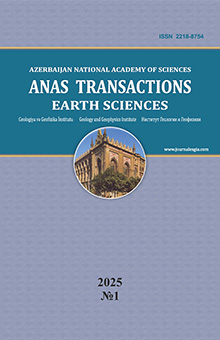Analysis of vulnerability and dynamic characteristics of a monolithic building using microtremor measurements
Oripov N.2, Alimukhamedov I.2, Yanbukhtin I.1, Musaev U.1, Zakirov A.1, Mamarozikov T.2
1 Center for Advanced Technologies within the Ministry of Higher Education, Science and Innovation of the Republic of Uzbekistan, 3a, University str., Almazor district, Tashkent, 100174: nozim.o.k92@gmail.com, ilhom75@mail.ru, Ilyas9348702@gmail.com, ulugbek-1975@mail.ru, azamatzakirov@mail.ru, timur.mamarozikov@yandex.ru
2 Institute of Seismology named after G. Mavlyanov, Academy of Sciences of the Republic of Uzbekistan 3, Zulfiyakhanim str., Tashkent, 100128
DOI: 10.33677/ggianas20240200127
Summary
Microtremor measurements are a widely recognized and effective method for evaluating the dynamic properties and potential seismic vulnerability of buildings. These measurements allow for the determination of critical parameters such as the dominant frequency, amplification factor, vulnerability index, and floor spectral ratio (FSR) for each floor of the building under investigation. In this study, microtremor measurements were conducted on a 26-storey monolithic reinforced concrete residential building located in the heart of Tashkent city. Recordings were made using six velocimeters simultaneously for 30 minutes. Measurements were taken on the basement floors (two floors), on the first floor, and then at two-floor intervals throughout the entire height of the building. Additionally, free-field measurements were taken on the ground outside the building to serve as a reference. The data was analyzed using GEOPSY software, which generated HVSR (Horizontal-to-Vertical Spectral Ratio) curves for the structure. The analysis showed that the building has the appropriate characteristics to effectively absorb seismic impact, indicating that it is well-constructed and capable of withstanding seismic forces. The strong structural integrity, demonstrated through low amplification and vulnerability indices, suggests that the building's design provides adequate protection against potential earthquake damage. These findings contribute to the broader understanding of how microtremor studies can be applied in the seismic evaluation of tall buildings in urban conditions.
Keywords: microtremor, natural frequency, FSR, HVSR, vulnerability index, resonance
REFERENCES
Gallipoli M.R., Mucciarelli M., Castro R.R., Monachesi G., Contri P. Structure, soil-structure response and effects of damage based on observations of horizontal-to-vertical spectral ratios of microtremors. Soil Dynamics and Earthquake Engineering, Vol. 24(6), 2004, pp. 487-495, DOI:10.1016/j.soildyn.2003. 11.009.
Gosar A. Microtremor HVSR study for assessing site effects in the Bovec basin (NW Slovenia) related to 1998 Mw5.6 and 2004 Mw5.2 earthquakes. Engineering Geology, Vol. 91, No. 2-4, 2007, pp. 178-193, DOI:10.1016/j.enggeo.2007.01.008.
Gosar A. Site effects and soil-structure resonance study in the Kobarid basin (NW Slovenia) using microtremors. Natural Hazards and Earth System Science, Vol. 10(4), 2010, pp. 761-772, DOI:10.5194/nhess-10-761-2010.
Hadianfard M.A., Rabiee R., Sarshad A. Assessment of vulnerability and dynamic characteristics of a historical building using microtremor measurements. Journal of Civil Engineering, Vol. 15, 2017, pp. 175-183, https://doi.org/10.1007/s40999-016-0086-2.
Herak M. Overview of recent ambient noise measurements in Croatia in free-field and in buildings Geofizika, Vol. 28(1), 2011, pp.21-37.
Irie Y., Nakamura K. Dynamic characteristics of a R/C building of five stories based on microtremor measurements and earthquake observations. In: Proc. of XII World. Conf. Earthq. Eng., Wellington, 2000, pp. 500-508.
Konno K. and Ohmachi T. Ground-motion characteristics estimated from spectral ratio between horizontal and vertical components of microtremor. Bulletin of the Seismological Society of America, Vol. 88, No.1, 1998, pp. 228-241, https://doi.org/10.1785/BSSA0880010228.
Mokhberi M. Vulnerability evaluation of the urban area using the H/V spectral ratio of microtremors. International Journal of Disaster Risk Reduction, Vol. 13, 2015, pp. 369-374, DOI:10.1016/j.ijdrr.2015.06.012.
Nakamura Y, Gurler E.D., Saita J., Rovelli A., Donati S. Vulnerability investigation of roman colosseum using Microtremor. In: 12th World Conference on Earthquake Engineering, Auckland, New Zealand, 2000, pp. 2660-1-8.
Nakamura Y. Basic Structure of QTS (HVSR) and Examples of Applications. In: Increasing Seismic Safety by Combining Engineering Technologies and Seismological Data, Conference proceedings, edited by Mucciarelli M. et al., Dordrecht, Netherlands, 2009, pp. 33-51, DOI:10.1007/978-1-4020-9196-4.
Okada H. The microtremor survey method. Society of Exploration Geophysicists with the cooperation of Society of Exploration Geophysicists of Japan and Australian Society of Exploration Geophysicists, SEG Books. Science. 2003, 135 p.
Oynakov E., Ivanov R., Aleksandrova I., Milkov J., Popova M. Evaluation of the Nakamura vulnerability index of a cast-in-situ reinforced-concrete building from ambient noise records. In: Dobrinkova, N., Nikolov, O. (eds.) Environmental Protection and Disaster Risks. EnviroRISKs 2022. Lecture Notes in Networks and Systems, Vol. 638. Springer. Cham. 2023, pp.66-76, DOI:10.1007/978-3-031-26754-3_6.
Prakosa P.T., Ibad M.I., Kafi M.S., Burhanudin M.A., Rahmania A. (2015) Earthquake microzonation and strength building evaluation at Gelora Bung Tomo Stadium Surabaya using micro-tremor method. Proceedings of 7th International Conference on Physics and Its Applications 2014 (ICOPIA 2014), Vol. 1, 2015, pp. 14-20.
Sarkowi M., Wibowo R.C., Sunanda Yogi I.B., Yusuf M., Boka Y.S. Microtremor analysis to evaluate BMKG region III building, Bali, Indonesia. IJES – Iranian Journal of Earth Sciences, Vol. 14(2), 2022, 104-111, DOI: 10.30495/ijes.2022. 1942485.1659.
Sato T., Nakamura Y., Saita J. The change of dynamic characteristics using microtremor. The 14th WCEE – The 14th World Conference on Earthquake Engineering, Beijing, China, 2008, pp 17-25.
Satriyo A., Suryanto W., Anggono T., Al Kamali M.L., Yufi H.S. Study Characteristics of a Multipurpose Reactor Building G.A. Siwabessy using Floor Spectral Ratio. E3S Web of Conferences. Vol. 468, 2023, ICST UGM –The 4th Geoscience and Environmental Management Symposium, Article Number 09003, 2023, https://doi.org/10.1051/e3sconf/202346809003.
SESAME, Guidelines for the implementation of the H/V spectral ratio technique on ambient vibrations measurements, processing and interpretation, 2004, Available: http://sesame-fp5.obs.ujfgrenoble.fr/Delivrables/Del-D23HVUser Guidelines.pdf.
Sungkono S., Warnana D.D., Triwulan, Utama W. Evaluation of Buildings Strength from Microtremor Analyses. International Journal of Civil & Environmental Engineering, Vol. 11(05), 2011, pp. 6-12.
DOI: 10.33677/ggianas20240200127
